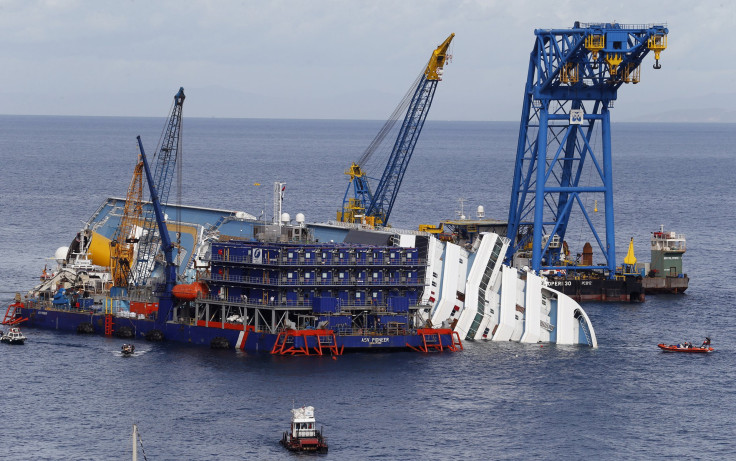Costa Concordia Anniversary: Where Is The Stricken Cruise Ship? Still There, And Not Going Anywhere

It’s been one year since the Costa Concordia struck an undersea rock off the island of Giglio on the coast of Tuscany and partially sank, on the night of Jan. 13, 2012, killing 30 and injuring 100 of its 4,200 passengers.
The Italian cruise ship’s captain had ordered to pass close to the coastline to “salute” the island, as was the custom among captains with Costa, a unit of U.S.-based Carnival Corporation (NYSE:CCL). Francesco Schettino said that he was unaware of the shallow bottom, and that after the ship hit the rock tearing a giant gash in the hull, he ordered counter-intuitively to steer closer to land to facilitate an evacuation.
Whether that is what really happened is still a matter of debate.
What is certain is that today the 114,000-ton, 950-foot (290-meter) cruise ship is still lying on its starboard side in the shallows in front of the island – and that it’s not going anywhere.
Italian Environment Minister Corrado Clini told reporters this month, according to several Italian press accounts, that the Concordia’s salvage operation -- an enormously complex undertaking by Titan -- Micoperi, a consortium of salvage companies, involving a procedure called “parbuckling” -- won’t begin until September, instead of in the spring as had originally been planned.
The risks for the environment are relatively low, as the ship’s fuel has already been pumped out. But the remains of the last two missing people from the disaster may still be inside the giant hull. And the port of Piombino, where the Concordia was going to be towed, has turned out to be too small for the ship with the salvaging rig around it.
All that while Captain Schettino mounts a media assault in an attempt to repair his image -- he became an internationally reviled figure after he abandoned the sinking ship, spurring a wave of outrage -- and the Italian prosecutors who concluded the investigation last month get ready to go to trial.
Schettino, who has spent the past year under house arrest awaiting trial on multiple charges of manslaughter, shipwreck and abandoning ship, is as belligerent as ever in the defense of his actions that January night. In an interview last week with Italy’s La Stampa daily, the disgraced captain complained that “I’ve been painted as worse than bin Laden.”
A recording of a phone call between Schettino and a Coast Guard officer that surfaced days after the accident turned the Costa captain into a figure of ridicule. “Get the f--- back on board!” the officer yelled at Schettino, who complained, while sitting in a life raft, that the darkness made it hard for him to try and do that. “So you’re going to go home because it’s dark, captain?” the officer snarled. (A T-shirt bearing the officer’s unprintable Italian invitation to regain the ship sold briskly throughout the country.) “I honestly do not recognize the image that they’ve painted of me, making ridicule of my 30 years of experience (…) and of my country’s image, exposing it to often unjust criticism from the whole planet,” Schettino told the paper, adding that he is “sincerely pained, from the bottom of my heart.” But why did the ship crash into the rocks? “That night I wasn’t given the right information. I might have made mistakes but I wasn’t alone,” said the captain.
One of the crew members who may have made mistakes is helmsman Jacob Rusli Bin, who according to what has transpired from the investigation misunderstood the captain’s orders and made at least two wrong turns. The problem is that the man, who may be indicted in February along with Schettino, is nowhere to be found. He disappeared after the accident and may be in his native Indonesia, where the Interpol has repeatedly tried to serve him with a subpoena from Italy but hasn’t been able to locate him, prosecutors said.
Nine people including the captain may be indicted next month, when a judge in the Tuscan city of Grosseto will decide whether there is enough evidence to go to trial. The decision is widely expected to be in favor of going to court. The documentation accompanying prosecutor Francesco Verusio’s case runs, according to the Italian press, to 50,000 pages.
© Copyright IBTimes 2024. All rights reserved.






















